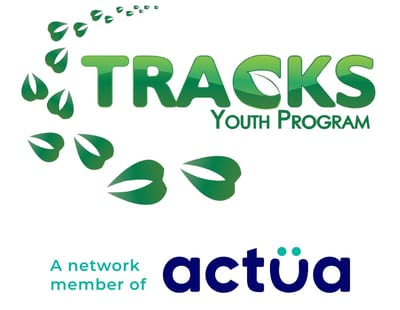Blog: PA Day Highlight through the Eyes of Lauren MacLachlan
Today is April 24th and would have been our first PA Day camp of the Spring! But due to COVID-19, we are instead reminiscing in the amazing day we had during our last PA Day camp on January 31st. Read all about it through the eyes of Lauren MacLachlan, who worked with TRACKS as Office and Programming Support through the Winter and Spring.
Aaniin! Hello!
My name is Lauren MacLachlan, and I worked with TRACKS from January 2020 to April 2020 in the position of Office and Programming Support. Working with TRACKS has been an amazing experience. It’s truly a gift to be doing work I so strongly believe in surrounded by such an amazing and supportive team.

One of the highlights of my time working with TRACKS has been the January 30th PA Day. The theme of our PA day was place, mapping, and reading the land. It was a wonderful day, where I felt like all the kids had gone home having had fun and having learned something new. started our day in the tipi going over protocols and the four directions. After that we joined Glen Caradus in the Gathering Space where he facilitated a life size board game based on the Adventures in Understanding canoe trip where Indigenous and non-Indigenous youth paddle from Little Lake all the way to Curve Lake. The board game is a giant map that allows campers to experience some of this adventure even though they are not in canoes themselves. The game pieces are small birch bark canoes that the kids move along the map starting from Little Lake up to Curve Lake, passing by significant places such as Kinoomaage-Waapkong (the Petroglyphs). Depending on the squares you land on you are either asked a nature-based question, or a question about local First Nations. I was really impressed by the kids answers and knowledge. Anishinaabemowin was mixed in throughout the game and it was nice to see how the kids picked up some words and how many of the words they already knew.


The personal highlight of the day for me was in the afternoon when we broke off into groups and I led a story and place activity. I was unsure of how it would go, but I was excited to try. It went really well and after everyone had shared a story and we were finished, we started looking at animal tracks and talking about animal behavior in the winter. Earlier in the day when we were in the tipi I had shared with some of the kids that if they ever see a bunch of chewed up cedar at the foot of a tree, they should look around for a porcupine. Porcupines love to sit at the tops of cedar trees and munch on the branches. As we walked around the cedar grove looking for various animal tracks, one of the kids noticed there was a bunch of cedar branches on the ground. I asked them “who can remember what that might mean?” Their eyes lit up and the kids excitedly exclaimed “A Porcupine!” They then eagerly looked around to the tops of the trees with one of the kids spotting a big porcupine up in the tree. Everyone was very happy, and excited. The kids then became very focused, attentive, and were eager to keep looking for more porcupines and animal tracks. Understanding that we wanted to be quiet, we softly walked through the forest and it was so nice to see the kids be so focused and inspired by the environment. We met up with the other group and the kids noticed more branches and found another porcupine! It was great to see them explain to the other kids about animal tracking, how to look for porcupines, and share their knowledge. At this point all of our groups got together, and everyone was very excited to look for more animals and learn about their behaviour in the winter. We happily walked through the forest finding deer, rabbit, bird tracks, and even a few deer beds.


I found this moment to be so special because learning had come full circle. They were able to learn some nature-based skills and apply it right away. I think it reinforced that what the kids are learning with TRACKS are not abstract concepts but every day ways to understand our surroundings and connect to the land. This wasn’t something that we planned for in our programming, which is one of the things that makes environmental education so much fun- you never know what you might find and what lessons the land will teach you that day. It was great to see the kids find so much joy from spending time in nature during the winter, and to see everyone so engaged and asking questions and sharing information with each other.
The last activity of the day was Ozobots. Ozobots are small little robots that read different colour codes. The kids drew maps and mazes utilizing different colours to correspond with the movements they wanted the Ozobots to make. During this activity it was really nice to see the kids trying new things, playing around with different ideas, and working together to make new paths for the Ozobots.
I am very grateful that I got to be a part of this PA day, and it is definitely a memory I will cherish from my time working for TRACKS.
Miigwetch!
By Lauren MacLachlan
